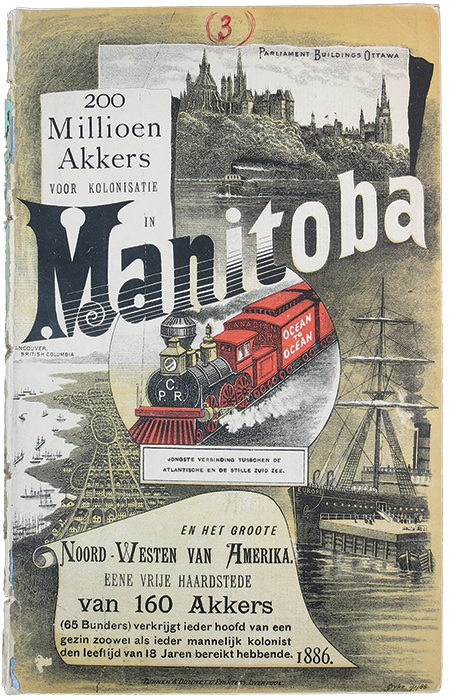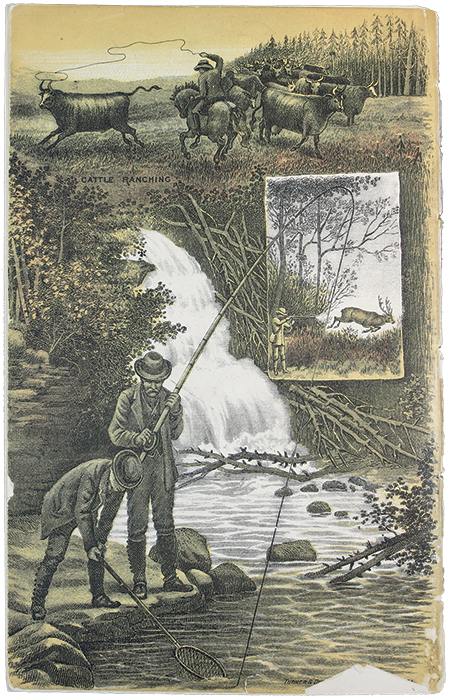by Heidi Rees
Manitoba Legislative Library
|
 |
Pamphlets in the 1880s attracted European emigrants to Manitoba
|
In your home in Oslo, might you be enticed by the idea of “... 200,000,000 Acres dyrkbart landsom nu ligger urört og venter Settlerens Ankomst.”? [1] Or be curious about an acquaintance who declares that the climate in the North-West Territories of Canada encourages good health, that “children coming from any of the countries of Europe get very fleshy.” [2]
These phrases were meant to appeal to those living in overcrowded cities, polluted manufacturing regions or those struggling to establish financial independence within an often rigid hierarchical society. In the mid-1880s to the early 1900s, Canada and its provincial governments and companies such as the Canadian Pacific Railway created and distributed pamphlets specifically to attract British, northern and western Europeans to Canada. [3] The immigration pamphlets attempted to entice these ethnic groups with offers of land, equipment, economic freedom and a healthy environment and lifestyle. [4] Immigration offices located throughout Great Britain and Europe distributed these documents and provided information and support with moving to this unfamiliar and slightly mysterious part of North America.
 |
These pamphlets use similar techniques to capture the attention of potential immigrants. Coloured covers are used to attract the reader initially while photographs and pictures within the document are used to corroborate the presented information. For example, many pictures show idyllic farming conditions: healthy, well-behaved horses, content cattle, new equipment, a gentleman in his waist coat. [5] One particular set of pictures appears regularly in a variety of pamphlets about Manitoba. Specifically, a pair of before-and-after pictures of Winnipeg emphasize the growth and development of the city. The picture of Winnipeg in 1871 features ox carts, trails and teepees with few wooden structures in the background. The 1883 picture, just over ten years later, highlights the rivers complete with steamboats and bridges and the city with organised streets and European-style housing as well as church spires dotting the scene. [6]
Some pamphlet covers illustrate the industrial dynamism of life in Canada. One recurring cover [7] features a train and railway tracks with the Parliament Buildings of Ottawa in the background. Steamer ships arriving on the East Coast and the developing harbour in Vancouver add to the picture of Canada as expansive, and perhaps remind the reader of the expanse of opportunity that this country entails. Moreover, the transportation theme of this cover may have served to remove the notion of regional isolation that potential immigrants may have had.
However, scenes of bucolic countryside do abound in most of these pamphlets. Pictures of recreational fishing [8] and hunting, [9] sightseeing, [10] and lake life [11] reinforce the natural purity, healthy climate and accessible leisure of life in Canada.
The emphasis on Manitoba and Canada as a civilized region and country, respectively, is reflected not just in the pictorial presentation but also in the language used in these documents. For example, the education system is described “as perfect as it is simple” [12] and that “[l]ong before school boards were established in England, Canada was in the enjoyment of a well-organized educational system.” [13] This language suggests that the Canadian model is not equal to but an improvement on the education system in England. Canada, the author suggests, is truly civilized because “... the children of the poor have the same opportunities as the children of the rich.” [14]
Similarly, the Canadian administration of justice is described as an improvement on the adopted British system. Legal professionals are not separated into different categories but rather “barristers, attorneys and solicitors...are united in the one person.” [15] And the system as a whole is described having “a pure, honest, fearless judiciary; good wholesome laws; [and] and impartial administration of justice.” [16]
The language used to promote the civility and equality of this new country is contrasted with language that warns immigrants that “Canada is no place for the idler or the dissipated.” [17] Throughout these pamphlets, the opportunities for wealth, health and peace are portrayed as a result of hard work and commitment. “The Canadians are a nation of workers—a lazy man they despise—therefore, let the lazy man remain in Europe unless he be willing to shake off his droning habit and so become a worker in the hive of industry.” [18] In publications containing testimony of previous settlers, the theme of industriousness continues. “A strong, healthy man can obtain an independent position in this country. He will have hardships to encounter at the outset, none but what a vigorous resolution can surmount.” [19] Ultimately, “as he surveys his own fertile fields, he feels within him a spirit of freedom and independence such as is not enjoyed by the working farmer of any other country under the sun.” [20]
An important feature of these immigration pamphlets is the audience at which they are targeted. One pamphlet introduces the idea that people from certain regions [21] should consider Canada: those “... from the British Islands, from Germany, Northern France, southern Russia, or Norway and Sweden.” Later in the same publication, the author declares “... there is ... no country more suitable in every respect for settlement by persons from the temperate and northern parts of Europe than the Province of Manitoba.” [22] To this end, the languages in which these pamphlets were published include Danish, Dutch, French, German, Norwegian and Swedish, in addition, of course, to English. Francophones from other areas of North America were also targeted in these publications. Further, delegations from Quebec, Minnesota, Kansas and Wisconsin all comment that Manitoba has excellent agricultural features which would lead to a good life “avec la grâce de Dieu.” [23] An implied endorsement by the Archbishop of Saint Boniface [24] may have encouraged Francophones to consider Manitoba.
While tenant farmers and agriculturalists are encouraged to immigrate to Canada, these pamphlets do encourage any person from these regions of Europe to consider such a move. “One special instance cited was that of a waiter ... who had immigrated to Manitoba, taken up a free grant of land, and settled down as a fairly successful farmer, his previous occupation having been the most unpromising introduction to that of an agriculturalist.” [25] Similarly, “[a] colony of East Londoners were settled in the North-West Territories ... near the Moosomin station ... and they have already adapted themselves to the ways of the country and done fairly well.” [26]
The Manitoba Legislative Library contains over 200 documents in its Immigration Pamphlet Collection. These documents were produced by a wide range of governments and non-governmental organisations including the Government of Canada, usually the Department of Agriculture or the Department of the Interior, the Government of Manitoba, Canadian Pacific Railway Company, the Land Department of the Manitoba & North-Western Railway, local authorities such as the Town of Minnedosa or the Board of Trade for the Village of Austin (Manitoba), rural municipalities such as Dennis County (Manitoba), the City of Regina and the Territory of Assiniboia or cooperative organisations such the Lorne Agricultural Society (Prince Albert, North-West Territories).
Because the items in this collection are often unique and very rare, access to and use of some pamphlets is restricted or sometimes prohibited. However, through a partnership with the University of Alberta’s Peel’s Prairie Provinces, [27] many of these documents have been digitized and are available online. Items such as “Manitoba ved Red River dalen i det store Nordvestlige America hvor henimod 200 millioner acres af det rigeste prairieland det bedste hvedeland er bleven aabnet ...” (in Norwegian) [28] are accessible and free and can used by scholars, researchers and the avocational historian without restriction.
These pamphlets are an example of government policy in action. Examining the pictures, scrutinizing the language and identifying the patterns of publication lend insight not only on the subject of immigration policy, but also on the techniques of late 19th-century advertising and perhaps also on the state of mind of those at whom the advertising was aimed.
1. Canadian Pacific Railway Company. Manitoba ved Red River dalen i det store Nordvestlige America hvor henimod 200 millioner acres af det rigeste prairieland det bedste hvedeland er bleven aabnet af den nye Can. Pacific Iernbane og hvor 160 acres frit land (ca. 600 maal) anvises ankommende nybyggere af regjeringen 1884. Turner & Dunnett, 1884.
2. Canadian Pacific Railway Company. What women say of the Canadian North West. Winnipeg Daily Sun, 1886. p. 15
3. Department of Agriculture, Canada. Canada: a handbook of information for intending emigrants, Dept. of Agriculture, 1877. p. 74-76.
4. Ibid. p. 51: “[T]he climate of Manitoba and the North-West is pleasant and healthy. It may be added, the dryness of the air, the character of the soil, which retains no stagnant pools to send forth poisonous exhalations, and the almost total absence of fog or mist, the brilliancy of its sunlight, the pleasing succession of its seasons, all conspire to make Manitoba a climate of unrivalled salubrity, and the future home of a healthy, prosperous people, strong in physical, intellectual and moral capabilities.”
5. Canadian Pacific Railway Company. Manitoba en het Noord westelijk gebied (Noord Amerika): verslag omtrent het klimaat, den bodem, de producten en bronnen van inkomst voor kapitalisten, landbouwers, ambachtslieden, arbeiders, dienstboden, enz. : met bizondere betrekking op Hollandsche en vlaamsche kolonisten. Turner & Dunnett, 1886. p. 11
6. Ibid, p. 12-13.
7. Ibid.
8. Ibid; p. 18 and back cover.
9.Manitoba en het Noord westelijk gebied (Noord Amerika): verslag omtrent het klimaat, den bodem, de producten en bronnen van inkomst voor kapitalisten, landbouwers, ambachtslieden, arbeiders, dienstboden, enz. : met bizondere betrekking op Hollandsche en vlaamsche kolonisten. [Dutch]. 1886; document id 107635909; p. 33. [Peel’s 1387].
10. Department of Agriculture, Canada. A guide book containing information for intending settlers with illustrations. Dept. of Agriculture, 1887. p .47
11. Ibid, p. 3
12. Department of Agriculture, Canada. Canada: a hand-book of information for intending emigrants. Dept. of Agriculture, 1877 p. 17.
13. Ibid, p. 16
14. Ibid, p. 18
15. Ibid, p. 20
16. Ibid, p. 20
17. Ibid, p. 4
18. Ibid, p. 74-75.
19. Canadian Pacific Railway Company. What settlers say of the Canadian North-West: a plain statement of the experiences of farmers resident in the country. Canadian Pacific Railway Company, 1886. p. 44.
20. Department of Agriculture, Canada. Canada: a hand-book of information for intending emigrants. Dept. of Agriculture, 1877, p. 76
21. Ibid, p. 74
22. Ibid, p. 52
23. Révérend Père M.J. Blais, Ptre, O.M.I. Le Manitoba: renseignements et conseils aux Canadiens-français de la province de Québec et des États-Unis. Government of Canada, 1898, p. 47
24. Révérend Père M.J. Blais, Ptre, O.M.I. Le Manitoba: renseignements et conseils aux Canadiens-français de la province de Québec et des États-Unis. Government of Canada, 1898.
25. Department of Agriculture, Canada. A guide book containing information for intending settlers with illustrations. Dept. of Agriculture, 1887, p. 139
26. Ibid, p.139
27. http://peel.library.ualberta.ca/index.html (accessed 29 October 2015)
28. http://peel.library.ualberta.ca/bibliography/1221.html (accessed 29 October 2015)
We thank Clara Bachmann for assistance in preparing the online version of this article.
We thank S. Goldsborough for assistance in preparing the online version of this article.
Page revised: 11 December 2020